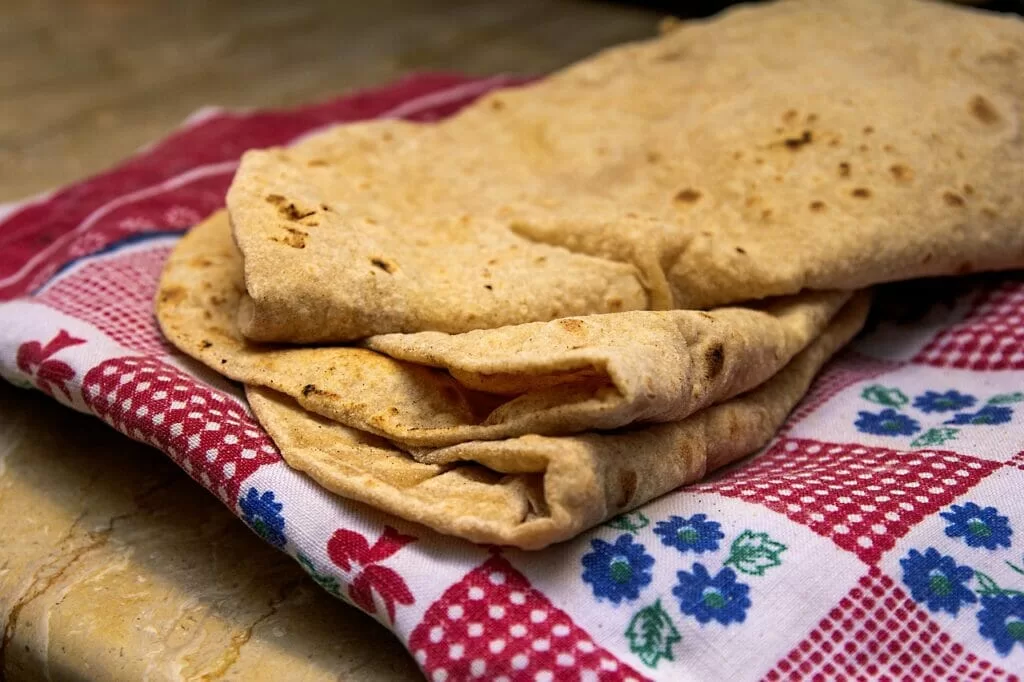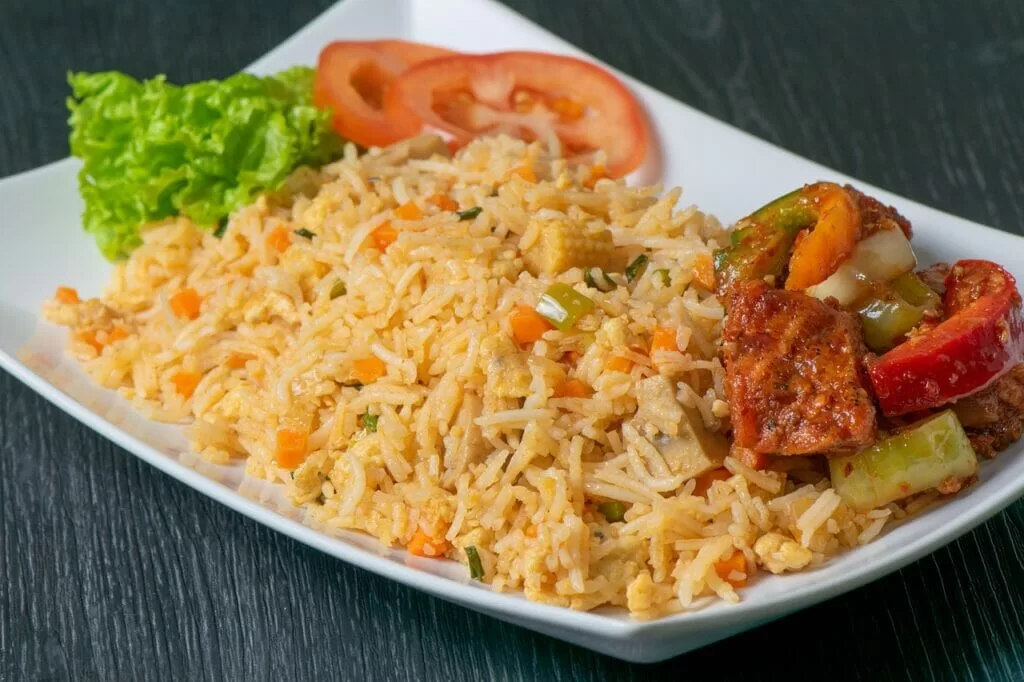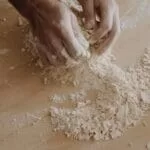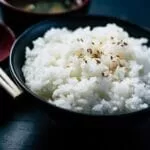There are two staple elements of Indian cuisine, roti and rice, that you probably eat for breakfast, lunch, or dinner. However, there is always this debate about which one is better, roti or rice? How can both grains be made better? What are you eating every day? This article will debunk some of the biggest myths surrounding this confusion between roti vs rice.
Roti vs Rice : Nutritional values
First, let’s compare the nutritional information of whole wheat roti and white rice. For example, a medium-sized roti provides around 100 calories, 20 grams of complex carbohydrates, 3.5 grams of protein, 2.5 grams of fibre and a negligible amount of fat. In contrast, one serving of cooked white rice contains 242 calories, 53 grams of simple carbohydrates, 4.43 grams of protein, little dietary fiber and almost no fat.
If we look only at macros, roti wins and, quite obviously, because it is whole grain vs white rice. In terms of vitamins and minerals, whole grains are richer in vitamins and minerals that support the health of our skin, hair, and all other body parts
Glycemic Values of Roti Vs Rice
We should also know and understand the glycemic index of roti and rice, as I am sure many of you would be concerned about its glycemic index. GI or glycemic index is simply a parameter of how a portion of food affects your blood sugar levels, and point to remember that the more the glycemic index, the more it will spike your insulin levels, which is bad for you.
Rice and whole wheat roti have a glycemic index of 73, while white rice has a glycemic index of 62. However, white rice is not as bad as you may think. If you have white rice, which has high gi (Glycemic index ) but also consumes fibre packed curry, salad or buttermilk etc., then its GI (Glycemic index ) changes, and now it doesn’t spike your insulin very high. Glycemic index is just a relative number; eat roti or rice; it depends on your overall meal
What is Gluten?
Now let’s briefly discuss gluten. Gluten is a plant protein present freely found in wheat, whereas rice is gluten-free. But does that mean you should not eat wheat as the Western world is screaming the new fad about gluten-free diets?
The answer is not really, and one should only avoid gluten if one is allergic to it. And that’s very obvious, just like you would avoid peanuts if you are allergic to them.
Roti vs Rice in Indian Scenarios
As for now, we’ve only seen half of the picture. In India, whole wheat roti and white rice were the most commonly used varieties. Now let’s dig deeper and find out which is the best variety of grains for daily consumption.
Apart from white rice, many more varieties are now getting popular. One most commonly heard is brown rice. In the beginning, modern science was all up for brown rice because it is high in fibre and is full of micronutrients, although recent reports are coming in according to which brown rice has some antinutrients.
these micronutrients hinder the absorption of vitamins and minerals, so modern science is beginning to change its stance and now does not recommend it; however, Indian farmers always knew how to get the best out of rice. Even the Ayurvedic scriptures mention it as the art of hand pounding the rice.
Brown rice and its significance
Brown rice is beaten, which removes the nutrients. Physics tends to bind with vitamins and minerals, making them unavailable for your body, which is the best price for daily consumption.
Hand-pounded rice, commonly known as semi-brown rice. Of course, we Indians have always been consuming hand-pounded rice, which is now confined to the grassroots only. If you ask a farmer which rice he eats, you will know. On the other hand, did you know that white rice, which is polished rice, has become a widespread practice only from the 1970s, and the reason for its popularity is just the aesthetic appeal? How sad, right?
Polished rice has a longer shelf life and faster cooking time. However, there is no way to understand what chemicals were used to polish the rice.
So it’s advisable to switch to hand-pounded semi-brown rice with antinutrients removed and thus offers complex carbohydrates that don’t make your energy crash. It’s also not chewy and doesn’t take too long to cook.
Best rice as per Ayurveda
Hand-pounded red rice, commonly called Raktshali, is considered the best variety of rice in Ayurveda.
The red rice or Raktshali variety has more micronutrients than any other rice and is best for health. However, it’s quite costly and may not fit in your daily diet. You can have it sometimes, though, but prefer semi brown rice for everyday use.
What best Rotis are made of?
When it comes to roti, most of which are made with whole wheat, it is unnecessary to mention that refined wheat that is maida is devoid of nutrition and should be avoided. Despite being good for our health, whole wheat causes lethargy in our bodies. According to our ancient texts, you shouldn’t consume wheat at all three meals of the day to minimize its effect.

Ideal mix of atta
It is always best to mix wheat flour with other grains, so multigrain flour is highly recommended. Whenever you buy whole wheat, we suggest that you also buy mixed millet flour and mix them in a ratio of 2 is to 1.
Ratio doesn’t matter; the idea is to make the roti easier to digest and more nutrient-dense.
There is no specific rule about the ratio; the goal is to make the roti easy to eat and more nutritious. Mixing different flowers with whole wheat is quite common in India. One more most important thing, if you get flour prepared from a local mill, be sure that they use cryogenic grinders as they grind the seeds with less heat and retain more
nutrients. You can also buy online as most plants use cryogenic grinders. If you often face digestive issues after eating roti, you can buy wheat bran ( Chokar ) and mix it to make your roti even more fibre-rich. Best rotis are the ones that are made using multigrain flour.
Best ways of consumption for Roti and rice
It is not only tastier but also more healthy. So now that we know the best ways of consuming roti, now let us discuss the most important part the right way of consuming both these grains so that they don’t harm us rather give us the maximum benefit.
One pro tip for making roti is that the longer you knead the dough, the softer the roti will be and the faster it will digest. If you have problems digesting wheat, skip ghee over rotis instead, put ghee in curry.
Other ways to get roti digested better are combining cucumber salad in lunch and ginger salad in dinner. Did you know that tandoori roti is easily digestible? Please include it in your diet at times. Milk will put fat into your body if you knead the dough with it.
One common practice I have seen is people removing the starchy water from the cooked rice when it comes to rice.
Never do that as it is very rich in micronutrients. Instead, pre-assess the quantity of water that will be enough to cook the rice. Rice should be rinsed first and then soaked in water for a few hours before being cooked in the same water. In addition to being rich in micronutrients, this rice-soaking water is also very rich in minerals.
Best time to eat rice

Lunch is the best time to eat rice and It is also good to eat rice for breakfast, but it should only be consumed after adding a bay leaf and black pepper at dinner. Rice has a very low potency, and eating it at night when your digestive fire is already low can result in indigestion, weight gain, and coughing.
The addition of bay leaf and black pepper normalizes the potency of rice.
Winner of battle between Roti Vs Rice
In conclusion, hand-pounded semi-brown rice and multigrain roti are best for daily use. We hope now it is clear that eating roti and rice only according to their macronutrients is not very intelligent.
Ayurveda stresses understanding how things work rather than just focusing on what they are made of or their shape and form.
India has been fed both grains for generations, and both are superfoods.
Roti and rice should be part of your fitness plan if you eat them correctly with the aforementioned recommended methods.
References:- https://www.doctorinsta.com
What is better, Roti or Rice?

Rice does not have the same amount of fiber as Roti, so it does not fill up the stomach as quickly as Roti. Rice has a higher folate level than whole wheat roti, a water-soluble B vitamin. Roti contains more minerals, such as potassium, magnesium, sodium, protein, and calcium, compared to other foods.
How to prepare atta to make it better to eat?

It is always best to mix wheat flour with other grains, so multigrain flour is highly recommended. Whenever you buy whole wheat, we suggest that you also buy mixed millet flour and mix them in a ratio of 2 is to 1.
What is the best time to eat rice?

Lunch is the best time to eat rice and It is also good to eat rice for breakfast, but it should only be consumed after adding a bay leaf and black pepper at dinner. Rice has a very low potency, and eating it at night when your digestive fire is already low can result in indigestion, weight gain, and coughing.

.
No schema found.🔬 Reviewed for Scientific Accuracy by:
With over 15 years of academic and clinical experience, Dr. Gautam oversees the scientific and editorial integrity of educational content related to herbs, nutrition, and wellness.
ResearchGate Profile | ORCID
Dr. Khurana brings deep expertise in nutraceutical formulation, phytochemistry, and metabolic health. He reviews FarmPURE content to ensure alignment with evolving biochemical and plant-based research.
ORCID
All FarmPURE Blog content is reviewed by domain experts to ensure it reflects the highest standards of botanical integrity, scientific relevance, and practical guidance. Our mission is to promote better health and beauty through the power of organic herbs, spices, and plant-based wellness solutions.
Disclaimer: The information provided in this blog is intended for general wellness and educational purposes only. It is not a substitute for professional medical advice, diagnosis, or treatment. Dr. Rashmi Gautam and Dr. Nikhil Khurana participate as scientific reviewers only, and do not provide or endorse personalized medical recommendations. Always consult a qualified healthcare provider before making decisions related to your health.


Very Informative.
#NidhiBawa
Thank you
#thefarmpure